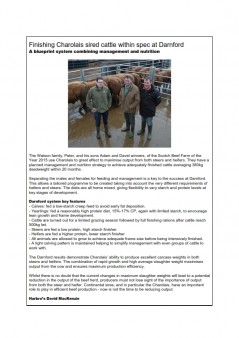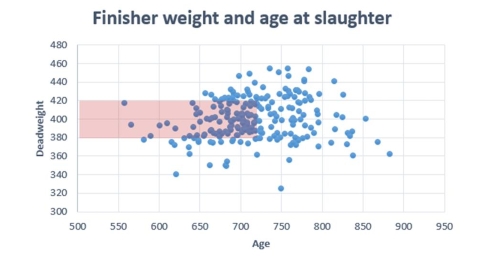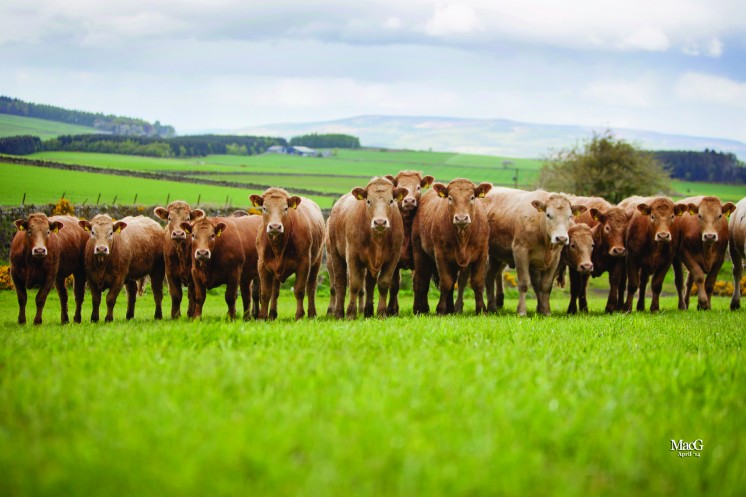Are the new abattoir specifications threating the use of Continental beef sires? The Watson family, of Darnford, Banchory, winners of the Scotch Beef Farm of the Year 2015 have proved that a planned management and nutrition strategy results in their Charolais cross steers and heifers adequately finished and averaging 380kg deadweight within 20 months.
 Click here Watson Family
Click here Watson Family
Recent changes to abattoir grading systems, and reduced upper weight limits for carcasses, have the potential to have a significant impact on beef production systems and the choice of genetics used within the suckler herd, writes Harbro’s Willie Thomson.
The success of breeding programmes and indices focussed on lean meat output and eye-muscle size has resulted in continental-sired cattle easily achieving lean carcasses at heavy weights (over 450kg deadweight). This has been readily adopted by beef producers to maximise output for both the suckler breeder and finisher, but has created growing problems in the meat industry as muscle size, particularly for high value steaks, has led to serious issues with pack size and portion cost.
In response to these challenges a growing number of abattoirs have responded by implementing upper weight limits on carcasses (many of these limits had been in place previously but never rigorously applied) in an attempt to pull down the number of carcasses causing significant problems.
This has seen upper limits reduced from 450kg to 420kg and even 400kg deadweight. There are discussions ongoing which suggest this limit may be reduced even further by certain abattoirs.
This creates a bit of a problem for breeders of continental sires. The very success of maximising lean gain may well create a scenario which generates greater uptake of smaller, native breeds.
The maximum weight issue is big enough without the additional concerns being raised by the increasing use of VIA grading in abattoirs and the apparent increase in the number of very lean (fat grades 1 and 2) carcasses, particularly for young bulls. We are now in the scenario where the top continental-sired barley bulls, which cannot be sold before 12 months as beef, have a carcass weight in the penalty band but yet have not achieved sufficient fat cover to be sold. You could argue that continental breeders have been too successful in achieving their goals!
So, what is the future for the continental sire?
The table below highlights the crux of the issue – that continental sires are associated with improved output of the steer and heifer; the issue is one of how to manage the progeny to fit market specifications.
| Steer | Heifer | Average | Av annual output | ||||
| Breed | Wt | Age | Wt | Age | Wt | Age | |
| Charolais | 397 | 716 | 333 | 655 | 365 | 686 | 194 |
| Continental 2 | 382 | 734 | 320 | 680 | 351 | 707 | 181 |
| Native 1 | 352 | 731 | 301 | 670 | 327 | 701 | 170 |
| Native 2 | 343 | 729 | 297 | 724 | 320 | 727 | 161 |
Arguably, one of the greatest inefficiencies within the UK beef industry is our sub-optimal output from heifers; any move away from continental sires threatens to exacerbate this. Whilst there is no doubt that the abattoirs need to control the specification of their input we are in the fortunate position where there is scope for the industry to compensate for the potential loss of output arising from lighter steer carcasses by focussing on improving the output from heifers. The same issue of lean carcasses which must be addressed for steers creates a huge advantage in producing greater levels of lean output from the heifer.
So, what can be done?
The following graph shows the variation in output from Scottish finishers producing Charolais cross steers. You can see the spread being presented to the abattoir, and possibly why they are imposing restrictions. However you can also see that there are a number of producers using the Charolais breed to produce average steer carcass weights within specification and at the same time utilising the excellent rapid growth associated with the breed.
In particular I have highlighted the producers targeting steer carcasses between 380kg and 420kg, but also achieving below average days to slaughter. If the strength of the breed is to be demonstrated by fast, efficient growth, these producers provide a potential blueprint for the management strategies required in future.
Above Left: Willie Thomson
Harbro Technical Director
Above right: David MacKenzie
Harbro Sales Manager
Willie Thomson
Technical Director | Harbro Limited | +44 (0) 1888 545204 | +44 (0) 7836 570190 | Willie.Thomson@harbro.co.uk
Markethill | Turriff | AB53 4PA | t: +44 (0) 1888 545200 | f: +44 (0) 1888 563939 | www.harbro.co.uk
Categories: Commercial, News
Border Agri-Expo » « Northern Ireland Beef Expo, Pedigree Calf Fair, 14 November



